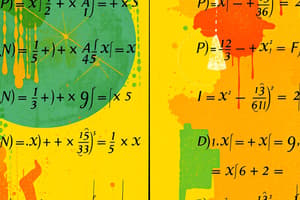Podcast
Questions and Answers
When solving the quadratic equation $x^2 - 6x + 5 = 0$ by completing the square, what is the constant term after moving it to the right-hand side of the equation?
When solving the quadratic equation $x^2 - 6x + 5 = 0$ by completing the square, what is the constant term after moving it to the right-hand side of the equation?
- 5
- 6
- -5 (correct)
- -6
Given the quadratic equation $x^2 + 8x + 12 = 0$, what is the value of $(b/2)^2$ that needs to be added and subtracted during the completing the square process?
Given the quadratic equation $x^2 + 8x + 12 = 0$, what is the value of $(b/2)^2$ that needs to be added and subtracted during the completing the square process?
- 4
- 16 (correct)
- 36
- 8
If a quadratic equation is transformed into the form $(x + 3)^2 = 4$, what are the solutions for x?
If a quadratic equation is transformed into the form $(x + 3)^2 = 4$, what are the solutions for x?
- x = -1, x = -5
- x = -1, x = 5
- x = 1, x = -5 (correct)
- x = 1, x = 5
What is the intermediate step of completing the square for the equation $x^2 + 4x - 5 = 0$?
What is the intermediate step of completing the square for the equation $x^2 + 4x - 5 = 0$?
What is the primary reason for using the completing the square method when solving a quadratic equation?
What is the primary reason for using the completing the square method when solving a quadratic equation?
Which quadratic equation, from the options provided, has no real roots?
Which quadratic equation, from the options provided, has no real roots?
Which point is a solution to the inequality $x^3 - 2x^2y + y^3 > 0$?
Which point is a solution to the inequality $x^3 - 2x^2y + y^3 > 0$?
A pizza has a diameter of 14 inches. What is its approximate area?
A pizza has a diameter of 14 inches. What is its approximate area?
What value of $x$ makes the equation $x^2 + 4x + 4 = 0$ true?
What value of $x$ makes the equation $x^2 + 4x + 4 = 0$ true?
Which of the following is a quadratic equation?
Which of the following is a quadratic equation?
Each of the following has a square root that is a whole number, EXCEPT:
Each of the following has a square root that is a whole number, EXCEPT:
If $x^2 = 100$, what are the solutions for $x$ by extracting square roots?
If $x^2 = 100$, what are the solutions for $x$ by extracting square roots?
What are the solutions to the quadratic equation $x^2 + 5x + 6 = 0$?
What are the solutions to the quadratic equation $x^2 + 5x + 6 = 0$?
Flashcards
What is a quadratic equation?
What is a quadratic equation?
A quadratic equation is an equation where the highest power of the variable is 2. It can be written in the standard form ax² + bx + c = 0, where a, b, and c are constants and a ≠ 0.
How do I solve a quadratic equation by factoring?
How do I solve a quadratic equation by factoring?
To solve a quadratic equation by factoring, we try to express the quadratic expression as a product of two linear factors. Then, we set each factor equal to zero and solve for the variable.
What is a square root?
What is a square root?
The square root of a number is a value that, when multiplied by itself, equals the original number. For example, the square root of 9 is 3, because 3 * 3 = 9.
How to solve a quadratic equation by extracting square roots?
How to solve a quadratic equation by extracting square roots?
Signup and view all the flashcards
What is the discriminant?
What is the discriminant?
Signup and view all the flashcards
What does a positive discriminant mean?
What does a positive discriminant mean?
Signup and view all the flashcards
What does a zero discriminant mean?
What does a zero discriminant mean?
Signup and view all the flashcards
What does a negative discriminant mean?
What does a negative discriminant mean?
Signup and view all the flashcards
What is the first step in solving the quadratic equation x² + 6x + 8 = 0 by completing the square?
What is the first step in solving the quadratic equation x² + 6x + 8 = 0 by completing the square?
Signup and view all the flashcards
What is the value of (b/2)² in the quadratic equation x² + 5x + 6 = 0?
What is the value of (b/2)² in the quadratic equation x² + 5x + 6 = 0?
Signup and view all the flashcards
What is the main goal of completing the square when solving a quadratic equation?
What is the main goal of completing the square when solving a quadratic equation?
Signup and view all the flashcards
What is the formula for solving a quadratic equation by completing the square?
What is the formula for solving a quadratic equation by completing the square?
Signup and view all the flashcards
Which of the following equations is in the form (x + b/2)² = (b/2)² - c?
Which of the following equations is in the form (x + b/2)² = (b/2)² - c?
Signup and view all the flashcards
Study Notes
Multiple Choice Questions - Mathematics 9
- Quadratic Equations: Questions focus on solving quadratic equations through various methods, including factoring, extracting square roots, and completing the square.
Identifying Quadratic Equations
- Quadratic Equation Definition: A quadratic equation is an equation of the second degree, typically written in the form ax² + bx + c = 0, where a, b, and c are constants and a ≠ 0.
Solving Quadratic Equations by Factoring
- Factoring Method: Students need to factor quadratic expressions and set each factor equal to zero to find the solutions (roots).
Solving Quadratic Equations Using Square Roots
- Extracting Square Roots: Quadratic equations in the form x² = c can be solved by taking the square root of both sides, resulting in x = ±√c.
Completing the Square
- Completing the Square Method: This method involves transforming a quadratic equation into a perfect square trinomial to solve for the variable. A key step is to add (b/2)² to both sides of the equation.
Quadratic Formula
- Quadratic Formula: The quadratic formula, x = (-b ± √(b² - 4ac)) / 2a, provides a general method to solve any quadratic equation.
Identifying the Correct Equation Form
- Standard Quadratic Form: Recognizing a quadratic equation written in the standard form ax² + bx + c = 0.
Recognizing a Solution Set
- Solution set: Determining if provided coordinates or points satisfy the solution set of a given inequality involving x³ and y³.
Finding area of a circle.
- Area of a Circle: The area of a circle is calculated using the formula A = πr², where r is the radius of the circle. Given a diameter of 14 inches, the radius is half of that.
Recognizing Whole Number Square Roots
- Identifying Perfect Squares: Students must identify numbers whose square roots are whole numbers, highlighting that numbers like √15 are not perfect squares.
Quadratic Equations with no real roots
- Discriminant: The discriminant (b² - 4ac) helps determine the type of roots a quadratic equation has. A negative discriminant indicates no real roots.
Determining if a quadratic equation has no real roots.
- Quadratic Formula and Discriminate: The discriminant (b^2 - 4ac) is a useful tool in determining the nature of the roots (real versus imaginary). If discriminant is less than 0, then no real roots exist.
Studying That Suits You
Use AI to generate personalized quizzes and flashcards to suit your learning preferences.




